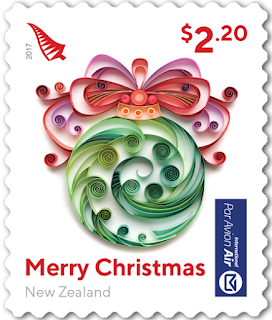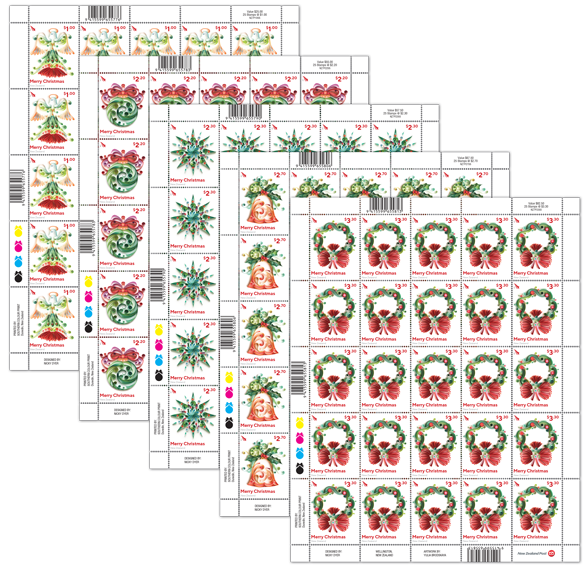 We often have visitors from Asia staying with us over the Christmas period. For them, a traditional Christmas is often something different, a new experience. So we go all out to celebrate it.
We often have visitors from Asia staying with us over the Christmas period. For them, a traditional Christmas is often something different, a new experience. So we go all out to celebrate it. First off, the Christmas tree. I get our visitors into the car to head off to the Christmas tree farm. Of course, there is that tired old joke about having to run fast to catch them. "Especially the little Christmas trees, really fast ones," I tease them. Yes, I always get those confused looks too. "What's he going on about."
We drive up through the farm to the area they are harvesting and are met by a guy with a saw. I let my guests wander through the trees looking for that special one, the one with that perfect cone shape. Then the guys will cut it and we are on our way home. The next step is setting it up. Out comes the plastic bucket and some bricks to go in the bottom. Selected bits of firewood work well to wedge the tree into position and we can pour in the water.
Some Christmas wrapping paper is fitted around to hide the plastic bucket and then we are ready to start the decorations. Out come the boxes of lights and other things to hang on the tree and I stand back allowing our guests to do all the work. Finally, all the lights in the room are turned off and we switch on the tree lights. Coloured lights, shining and flashing among the other decorations on the tree.
This stamp issue is about the traditional decorations used on Christmas Trees. There are eight stamps in all, five gummed stamps and three repeated in self-adhesive format. The purpose, stamps for people to place on their Christmas mail, both locally and overseas. The annual Christmas issue always goes on sale earlier enough for mail to reach its destination anywhere in the world before Christmas Day.
The Gummed Stamps.
$1.00 - Angel. $2.20 - Bauble.
$1.00 - Angel.
The story of the birth of Jesus has long influenced Christmas, from carols to stories to decorations. One of the most common Christmas decorations is the angel, which often takes pride of place at the top of the Christmas tree. Several angels appear in the Nativity story and each plays a crucial role as a messenger or guardian. As the angels often appeared hovering high above the earth keeping watch over the proceedings, this may explain why they have taken the spot atop Christmas trees.
$2.20 - Bauble.
As is the case with many traditional Christmas decorations, Germany is to thank for the creation of glass baubles. Originally people would use nuts, berries and marzipan to decorate their trees. These shapes evolved into decorative glass ornaments that were crafted by hand, and as a result were only available to the wealthy. With advances in technology, cheaper versions using different materials, texture, colour and sparkle were able to be produced around the world, making them more affordable and accessible to everyone.
$2.30 - Star. $2.70 - Bell.
$2.30 - Star.
Atop of most Christmas trees, you’ll find either an angel or a star. The star is another decoration that’s origins trace back to the Nativity story. At the time of the birth of Jesus, a bright shining star appeared in the sky and many flocked to the location beneath it to worship their new lord. The star is now a popular and common decoration associated with Christmas all over the world.
$2.70 - Bell.
The association of bells with Christmas has been around for a long time. Pagans used to ring bells to ward off evil spirits, while churches would ring bells to announce the beginning of mass or a wedding. Bells eventually became associated with happiness and celebration, and as a result were often rung throughout the Christmas season with merriment. They have since appeared in Christmas carols, as decorations and are a well-recognised symbol of Christmas.
$3.30 - Wreath.
$3.30 - Wreath.
This is another Christmas decoration that finds its origin amongst the pagan traditions in Germany. The tradition of hanging sprigs and branches of evergreens over doorways to celebrate the coming of new life, developed into the circular, wreath shape we know today. Another theory on its origin is that it comes from the laurel crowns that were worn by royalty in ancient Greek and Roman times.
The Self-Adhesive Stamps.
The three value self-adhesive set were repeats of three of the gummed stamps. They are designed for stamp booklets or dispensers where the buyer is expecting to use a quantity of the stamp.
$1.00 - Angel.
Dispenser - $100.00ppr 100 x $1.00. Booklet - $10.00ppr 10 x $1.00.
$2.20 - Bauble. Booklet - $19.80ppr 10 x $2.20.
(Buy 10 for the price of 9.)
$2.70 - Bell. Booklet - $24.30ppr 10 x $2.70.
(Buy 10 for the price of 9.)
Other Collectible Items.
This year three First Day Covers and a miniature sheet were available.
The Miniature Sheet containing all five gummed stamps.
Gummed Stamps First Day Cover.
Miniature Sheet First Day Cover.
Self-Adhesive First Day Cover.
Set of Plate Blocks. Set of Value Blocks.
Set of Full sheets.
A History of Christmas Tree Decorations.
(Taken from the NZ Post website)
Some of the first items used to decorate Christmas trees were as simple as fruit and nuts. Sprigs of holly and other seasonal flowering plants were also used, as well as candles, which were a bit of hazard until the invention of lights. As the custom of putting up a Christmas tree slowly began to spread through Europe and on to America, the ornaments became more diverse as people started experimenting with different materials.
The first tinsel was made of beaten silver and was much heavier and limited in colour compared to today’s vast array of glistening, colourful plastic and foil versions. Cookies, marzipan and other sweet treats were cut into different shapes such as circles, hearts and stars and hung on branches along with paper snowflakes and hand stitched angels.
This homemade style was overtaken in popularity when the art of glass blowing was taken up in Germany and delicately handcrafted baubles were produced. By the 1880’s, Germany was leading the world in handcrafted glass ornaments. Moulds of children, angels, bells and more saw the shape and style of Christmas decorations change once again.
With the popularity of celebrating Christmas on the rise, the Christmas decoration market began to boom around the world. Soon Japan and the Czech Republic were producing decorations to be imported into America and Europe. The invention of new technology and materials meant that mass production was possible. Suddenly everybody could have glittering, colourful decorations adorning their Christmas tree.
The particular style of art that has been used to create this year’s stamps is known as quilling. It’s thought that its origins date back more than 500 years, but it was at its most popular during the late eighteenth and early nineteenth centuries. The name came from the act of wrapping a strip of paper around a feather quill to create a tight coil. These days, people can get special tools and templates as well as machine cut strips to make their artworks even more detailed and precise.
Quilling’s popularity peaked in the early 1800’s as a hobby for ‘ladies of leisure’. Although previous to that it had been popular among nuns as a way of decorating sacred texts, containers and holy pictures.
Quilling has been brought back to life in recent years with many hugely talented artists such as Yulia Brodskaya who is responsible for the stamp artwork, choosing it as their discipline. A close look at the artworks displayed in this stamp issue gives an idea of the time, patience and skill required to create these vibrant works.
Technical information
| Date of issue: | 1 November 2017 |
|---|---|
| Number of stamps: | Five gummed and three self-adhesive |
| Denominations: | Gummed: $1.00, $2.20, $2.30, $2.70 and $3.30; Self-adhesive: $1.00, $2.20 and $2.70 |
| Designed by: | Nicky Dyer, Wellington, New Zealand; Artwork by Yulia Brodskaya |
| Printer and process: | Southern Colour Print Ltd, New Zealand by offset lithography |
| Number of colours: | Gummed: four process colours; Self-adhesive: four process colours plus red phosphor |
| Stamp size and format: | Gummed: 35mm x 46mm (vertical); Self-adhesive: 25mm x 30mm (vertical) |
| Paper type: | Gummed: Tullis Russell 104gsm red phosphor gummed stamp paper; Self-adhesive: Tullis Russell Red Phosphor PSA stamp paper |
| Number of stamps per sheet: | 25 |
| Perforation gauge: | Gummed: 14.286 x 13.895; Self-adhesive: diecut |
| Special blocks: | Plate/imprint blocks may be obtained by purchasing at least six stamps from a sheet. Barcode blocks are available in A and B formats. |
| Period of sale: | Unless stocks are exhausted earlier, these stamps will remain on sale until 31 October 2018. First-day covers will remain on sale until 31 December 2017. |
Some of the images in this post were used with permission from the illustrated catalogue of StampsNZ
You can visit their website and Online Catalogue at, http://stampsnz.com/
Information for this post came from.



















We appreciate your engagement with our content. To ensure a respectful and constructive community, please take note of the following:
- No Spam, Please: We do not tolerate spammy or promotional comments. Any such comments will be promptly removed.
- Moderation in Place: All comments are moderated to maintain a positive and inclusive environment. Please be patient, as it may take a little time for your comment to appear.
- Sign In with Google: To comment, please sign in using your Google account. This helps us maintain the integrity of our community and allows for better interaction.